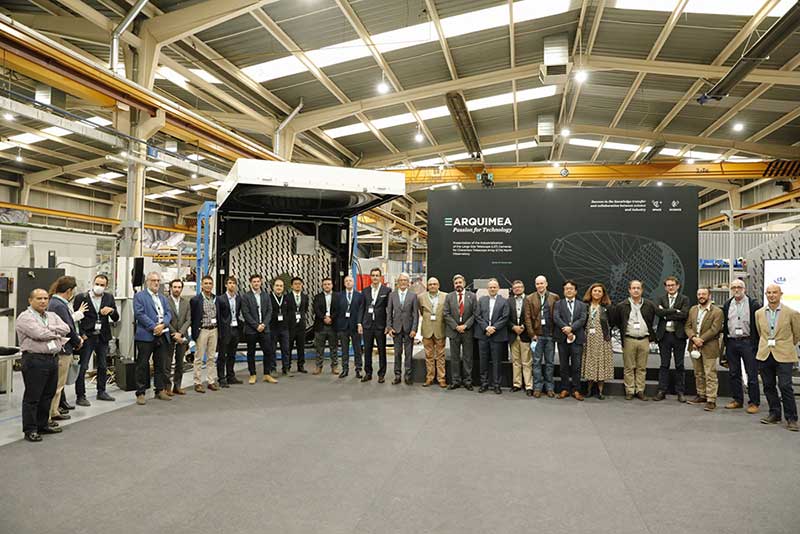- Sectors
- Aerospace & Defense
- Big science
- Fintech
- Insights

Madrid, 29th October 2021.
At its facilities in Torrejón de Ardoz, Madrid, ARQUIMEA, a technology company operating in high demand sectors worldwide, shared the results of industrialising cameras for the large size telescopes at the Cherenkov Telescope Array (CTA) gamma ray observatory, which is located on the island of La Palma, Canary Islands.
The event was attended by members of the CTA international consortium and research centres forming part of the project, including the Canaries Astrophysics Institute (IAC), the Centre for Energy, Environmental and Technological Research (CIEMAT) and the Institute for Cosmic Ray Research (ICRR) at Tokyo University. Representatives of the Ministry of Science and Innovation also attended.
The cameras were designed and made to meet CTA’s scientific targets and cover the observatory’s operational needs and the most demanding quality and safety standards. Each camera was designed to be as compact, light and efficient as possible while also giving optimum performance in energy detection.
Each 9 m2 camera, which will be suspended over the 20 m diameter telescopes, has 265 multipliers and weights two tonnes. The cameras are based on a modular design with all sensors and electronics on-board, ready to be installed in the telescope’s carbon fibre ring.
ARQUIMEA, because of its extensive experience in designing and manufacturing precision mechatronics with high added value, was awarded the contract launched by the IAC to manufacture, assemble, install and test the more than 5,000 different parts that make up each camera. The aim was to focus on a mass production approach, with a certified quality control system, while working with CIEMAT (responsible for the design and manufacture of the prototype telescope camera already in operation in La Palma) on implementing modifications to the design to facilitate the equipment’s manufacture, installation and maintenance.
In the words of Diego Fernández, Chairman of ARQUIMEA, “Spain has the industrial fabric, experience and technology to lead major scientific projects. Collaboration between science and industry has been key to manufacturing the cameras. At ARQUIMEA we are proud of having taken part in a project of this magnitude and contributing to being able to continue to study the frontiers of physics, our galaxy and the universe.”
The Director of CIEMAT added: “At CIEMAT we are fully aware of the high interest for society in the public/private collaboration that is capable of putting state-of-the-art skills and technologies into the hands of industry, and we believe in the importance of promoting this collaboration to drive a change in the economic model towards a knowledge-based one.
This project is a clear, successful example of how our commitment to this vision can materialise in projects that are highly attractive to society and place value on many years dedication to R+D+i and investment of public funds.”
Javier Herrera, the Project Manager from IAC, pointed out: “The contract launched by the IAC for production of the camera mechanics for the LST-2, LST-3 and LST-4 telescopes has been an example of the process of transfer of technology that was sought in the project, where, starting with a prototype designed by scientific institutions, it went on to industrialised production by European, and particularly Spanish, technology companies.”
The challenge to engineering and mechanical and electronic manufacture
The cameras are a key part of the telescopes. The LSTs have a 23 m diameter parabolic reflective surface, supported by a tubular structure made of reinforced carbon fibre and steel tubes. The 400 m2 reflective surface collects and focuses the Cherenkov light onto the telescope’s camera, where photomultiplier tubes convert light into electric signals that can be processed by dedicated electronics to collect fundamental information to study and analyse it. Although LST-1 is 45 m tall and weighs around 100 tonnes, it is extremely nimble, having the ability to reposition itself in 20 seconds to capture short-term, low energy gamma ray signals.
More than 100 telescopes measuring very high energy gamma rays
The Cherenkov Telescope Array (CTA) observatory is a global initiative to build the largest, most powerful gamma ray observatory in the world with more than 1,400 scientists and engineers from 32 countries taking part.
The observatory will consist of more than 100 telescopes spread over two areas. The northern hemisphere network will be located at the Roque de los Muchachos Observatory belonging to the Canary Island Astrophysics Institute (IAC) in La Palma, Spain. The one in the southern hemisphere will be in Chile, in the Atacama desert.
The observatory will have three types of telescope to measure different kinds of gamma rays: the largest will be 23 m in diameter, the medium-sized ones will be 12 m in diameter, and the small ones will be 6 m, dedicated to capturing the higher energy photons.
The scientific potential of the CTA observatory is extensive, from understanding the role of relativistic cosmic particles to searching for dark matter. The CTA Observatory will detect high energy radiation with a precision that is without precedent and a sensitivity that is approximately ten times greater than current instruments, providing data and new knowledge about the most extreme events in the universe.